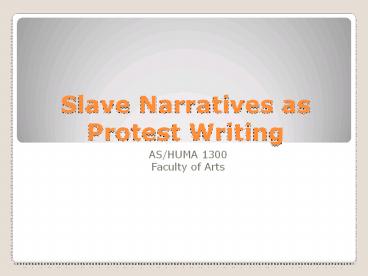Slave Narratives as Protest Writing - PowerPoint PPT Presentation
Title:
Slave Narratives as Protest Writing
Description:
Slave Narratives as Protest Writing AS/HUMA 1300 Faculty of Arts Course Outline: Slave narratives as protest writing 1.The Abolitionist Movement 2. – PowerPoint PPT presentation
Number of Views:44
Avg rating:3.0/5.0
Title: Slave Narratives as Protest Writing
1
Slave Narratives as Protest Writing
- AS/HUMA 1300
- Faculty of Arts
2
Course Outline Slave narratives as protest
writing
- 1.The Abolitionist Movement
- 2. Slave Narratives as Autobiography
- 3. Function of Narratives
- 4. Characteristics of Narratives
- 5. Gender and Slave Narratives
3
Abolitionist Movements
- British Caribbean
- 1770s-1830s
- British anti-slavery
- activists lobbying
- British Parliament
- Paternalistic
- Christianity.
- United States
- 1830s-1870
- Evangelical religious
- movements of the
- 1830s
- Active participation of
- northern blacks and
- ex-slaves.
4
Autobiography
- . . . autobiography must be understood as a
recollective/narrative act in which the writer,
from a certain point in his lifethe
presentlooks back over the events of that life
and recounts them in such a way as to show how
history has led to this present state of being.
(James Olney, Autobiography)
5
5 Functions of Slave Narratives
- 1. To document the conditions of or
- truth about slavery
- 2. To encourage the abolition of slavery
- 3. To provide religious inspiration
- 4. To assert the narrators personhood
- 5. To challenge stereotypes about blacks
6
Henry Louis Gates, Jr.
- . . . The black slaves narrative came to be a
communal utterance, a collective tale, rather
than merely an individuals autobiography. Each
slave author, in writing about his or her
personal lifes experiences, simultaneously wrote
on behalf of millions of silent slaves still held
captive . . . All blacks would be judgedon their
character, integrity, intelligence, manners and
morals and their claim to warrant emancipationon
this published evidence produced by one of their
number. (Classic Slave Narratives 2)
7
8 Characteristics of Slave Narratives
- 1. A preface as authenticating material or
- testimony
- 2. First sentence begins I was born . . .
- 3. Details of the first observed whipping
- 4. An account of a hardworking slave who
- refuses to be whipped
- 5. Details of the quest for literacy
- 6. Account of a slave auction
- 7. Description of attempts to escape
- 8. Appendix of documentary material
8
Mythological Pattern of Slave Narratives
- 1. Loss of innocence
- 2. Realization of alternatives to bondage
- and resolve to be free
- 3. Escape
- 4. Freedom obtained
9
Frederick Douglass
- It was a new and special revelation, explaining
dark - and mysterious things, with which my youthful
- understanding had struggled in vain. I now
understood - what had been to me a most perplexing
difficultyto - wit, the white mans power to enslave the black
man. - It was a grand achievement, and I prized it
highly. - From that moment, I understood the pathway from
- slavery to freedom. (Classic Slave Narratives
364)































